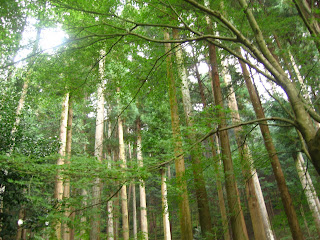 Rock Garden
Rock Garden Silver Pavilion
Silver Pavilion Forest
ForestI was very interested to see the Silver Pavilion. I already had a book about its maker, Yoshimasa, who was Shogun sometime in the 1300s (I think that it was the 1300s, I could be wrong). In fact, in the prelude of the book (which is all that I actually read) the author writes that he did not know much about the Silver Pavilion, or Yoshimasa. He commented that he didn’t understand why such a drab looking place got so much attention. Indeed, there is no Silver to be found anywhere in the Silver Pavilion, and it merely looks like an old wooden Japanese building. The original design was supposed to have silver leaf all around the outside of the building, but Yoshimasa died before that was able to happen, or there was some war that prevented such luxuries to be addressed. In any case, the building was never finished, and it still stands in its unfinished state.
The reason that I did want to see this place, though, is because of its function as a monument to Yoshimasa. He was not the most militaristic of Shoguns, but instead focused his attentions on the artistic and cultural flowering of Japan. It was under Yoshimasa that Japan had its equivalent to the Renaissance, when Noh theater, poetry, tea ceremony, and other arts flourished. So for that reason, I wanted to see this monument to the leader who allowed that to happen.
Other than the actual building, there was a nice garden to explore. However, one had to stay on a path, and that path was very crowded with other tourists, Japanese and foreign, who were all trying to get a nice view of the different things. What made this garden particularly stand out was its location. The grounds are right at the foot of the main mountain in Kyoto. This meant that on the other side of the fence, there were trees and bamboo growing all the way up the steep mountain. This made for a pleasurable sight.
No comments:
Post a Comment